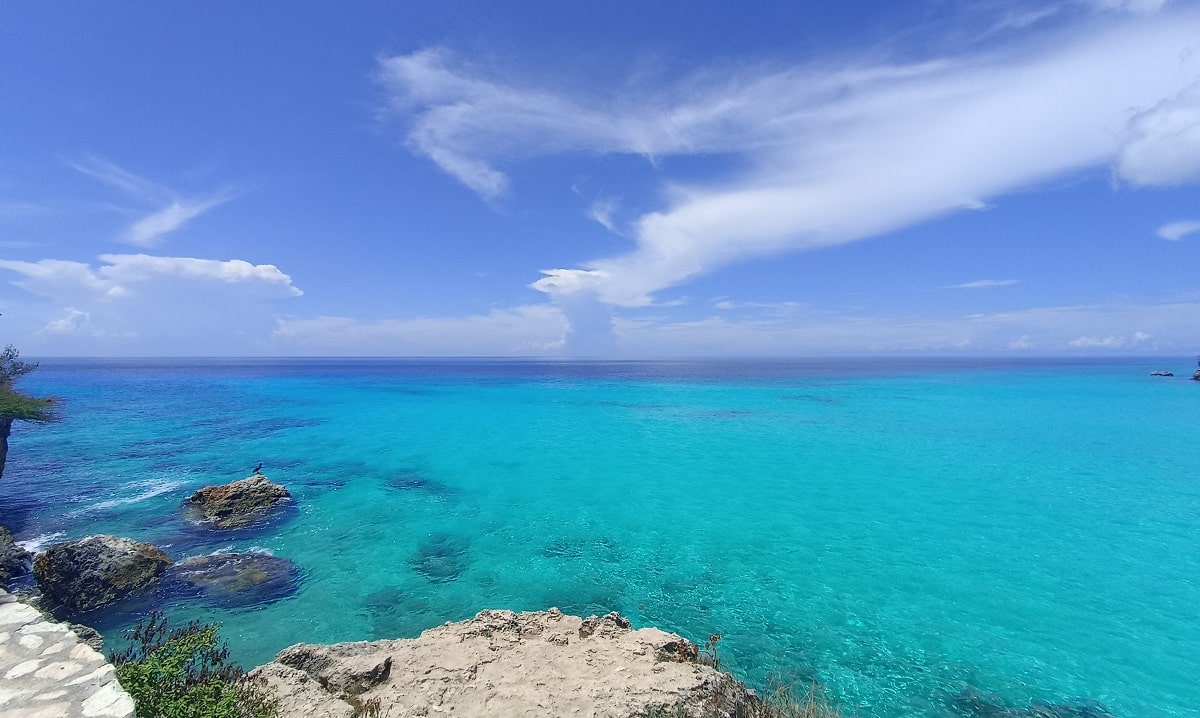Visiting the island of Curaçao in the Dutch Caribbean and want to experience life below the surface? You’re in luck! Snorkeling in Curaçao is an activity you can’t pass up, and there are many gorgeous beaches to choose from. You’ll love the abundant corals, colorful fish and funky invertebrates that call the reefs around this island home.
Let’s have a look at 11 of my favorite beaches for snorkeling in Curaçao, based on my own experiences gained while beach-hopping and exploring the island!
1. Playa Grandi or Playa Piskado
Came to Curaçao to see sea turtles? I’ll give you sea turtles. I saw them in the shallows and on deeper reefs in a bunch of different places, but the one spot where they’re almost guaranteed is Playa Grandi, also known as Playa Piskado.
At first glance, this beach is really nothing too special as far as the Caribbean goes. It has some basic amenities like beds and a bar, but it’s not particularly pretty. However, because local fishermen tend to use the dock to clean their catch, turtles have learned that there’s food to be found here. As a result, they flock to the area to score an easy meal.
Of course, this isn’t the most natural way to spot sea turtles, but it’s a great option if you’re worried you’re not going to manage to see one otherwise. Do remember that there can be a lot of other snorkelers in the water, so be polite and wait your turn to take a picture.
The water on the left side of the dock (as seen from the beach) at Playa Grandi was very cloudy when I went, but it was fine on the right. After marvelling at the turtles for a while, I swam to the shallow rocky area on the far right past the beach, where there’s plenty of other marine life to see.
| Amenities? | Yes |
| Busy? | Medium |
| Easy to reach? | Yes |
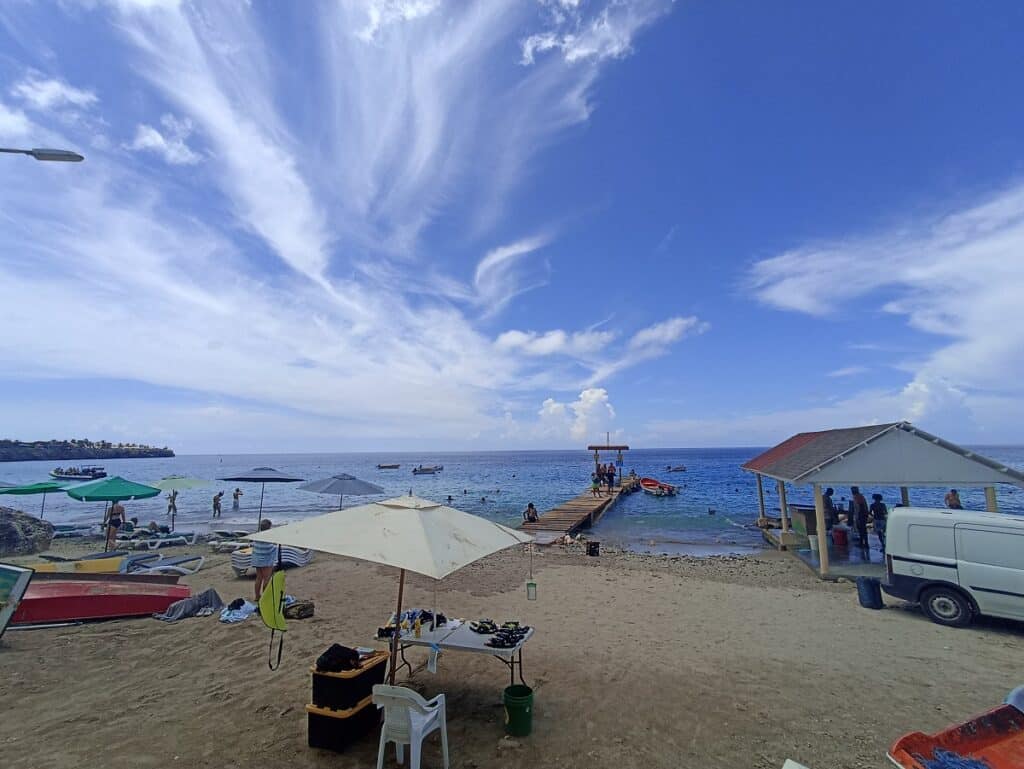

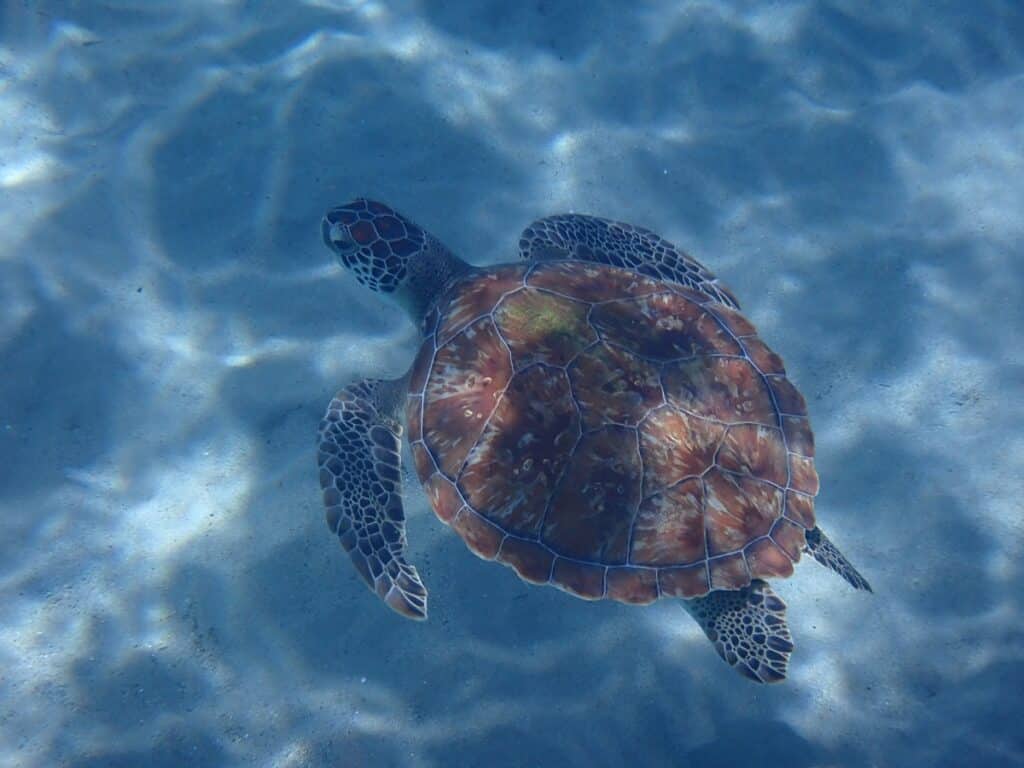
2. Grote Knip or Playa Kenepa
One of the prime beaches in Curaçao is Playa Kenepa, known in Dutch as Grote Knip. It has everything that comes to mind when you dream about a Caribbean holiday: azure waters, white sand, palm trees, and… excellent snorkel!
If you head to Playa Kenepa, keep in mind that it can be busy, and as with many beaches in Curaçao you’ll have to pay for a lounge chair. The advantage is that there are some amenities, like a little coin-operated shower and a small bar with some picnic tables that serves fried Dutch snacks.
To check out the underwater world, it’s easiest to walk all the way to the left side of the beach and get in the water there. Right in front of it, the water can be cloudy, and even if it isn’t, you generally won’t see much more than sand.
Once you’re in the water, you can keep swimming towards the left and explore the shallows. There’s usually not too much current and there’s plenty of life to see around the rocks. I spotted various coral species (the large fan corals were my favorites), sponges, fish, and even an octopus (though that one was quite well-hidden under a rock).
| Amenities? | Yes |
| Busy? | Yes |
| Easy to reach? | Yes |
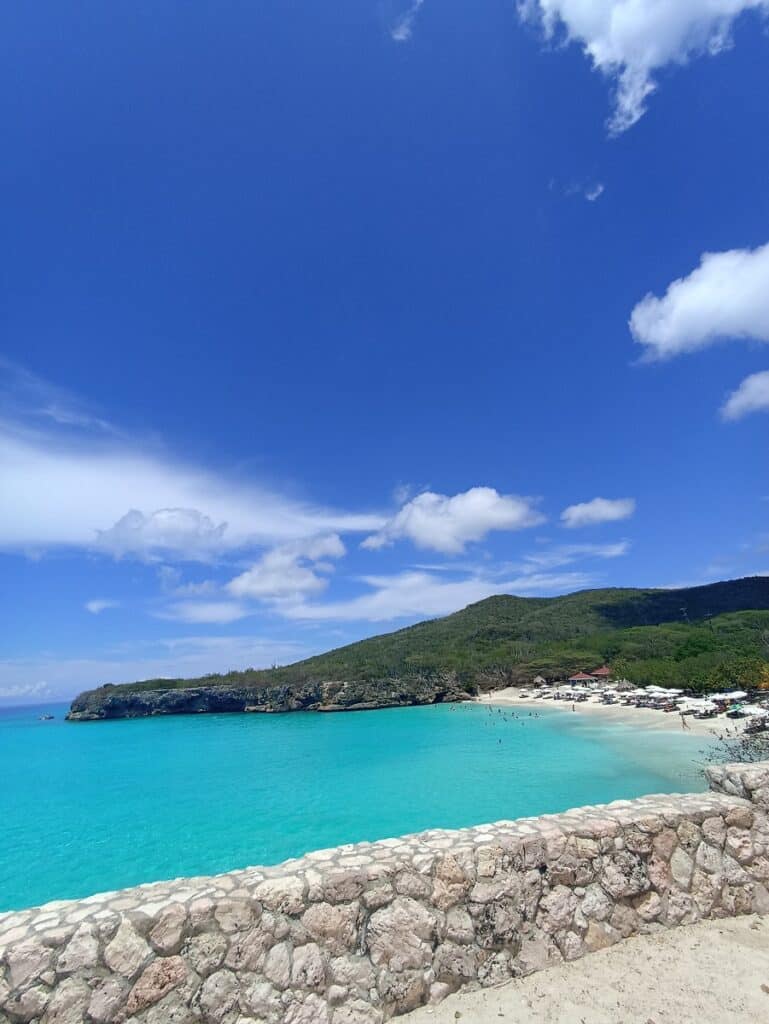
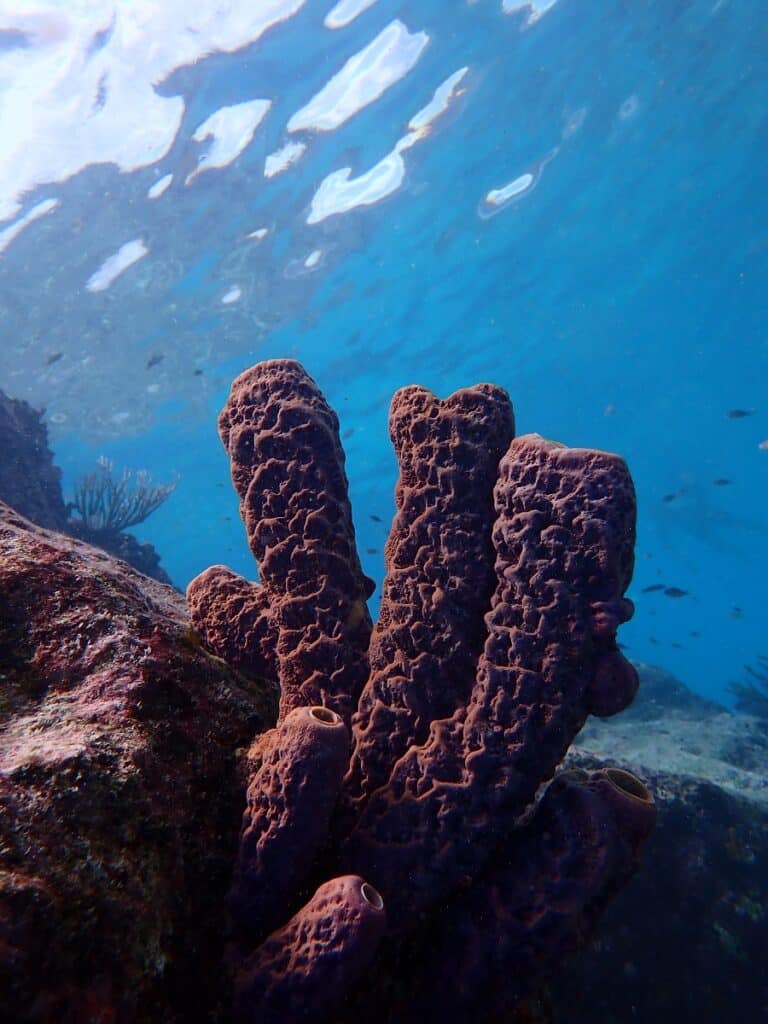
3. Kleine Knip or Playa Kenepa Chiki
Playa Kenepa Chiki, known in Dutch as Kleine Knip, is basically Playa Kenepa’s little sister. It’s smaller, but equally beautiful and a bit less busy. The two are located very close to each other, so you can absolutely visit both on the same day.
To snorkel Kenepa Chiki, your best bet is to get in the water on either side (not in the middle) and keep going along the edge. The water tends to be calm with not much in the way of currents, although you should always be careful to keep a bit of distance from the rocky edges at any beach to avoid getting slammed into them by the waves.
There are less amenities here than at Playa Kenepa, so if you need snacks, to use the restroom or to shower off the salt, it’s better to do so there. Apparently, you can rent snorkel gear, and there are some umbrellas with beds for shade.
| Amenities? | Limited |
| Busy? | Medium |
| Easy to reach? | Yes |
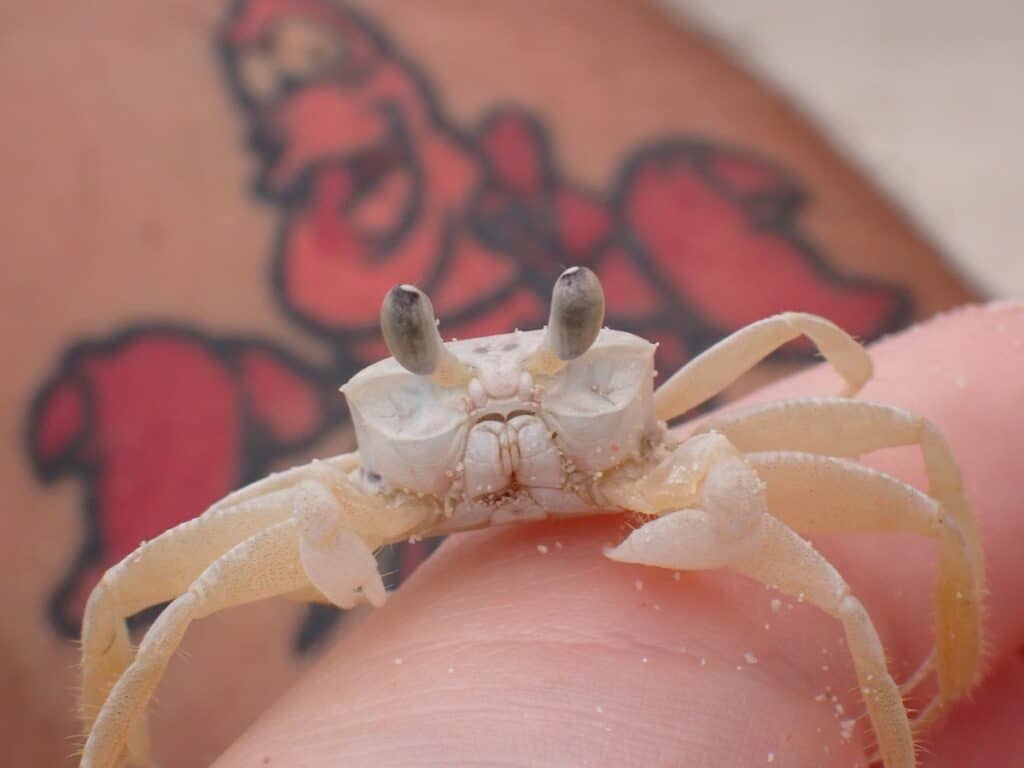
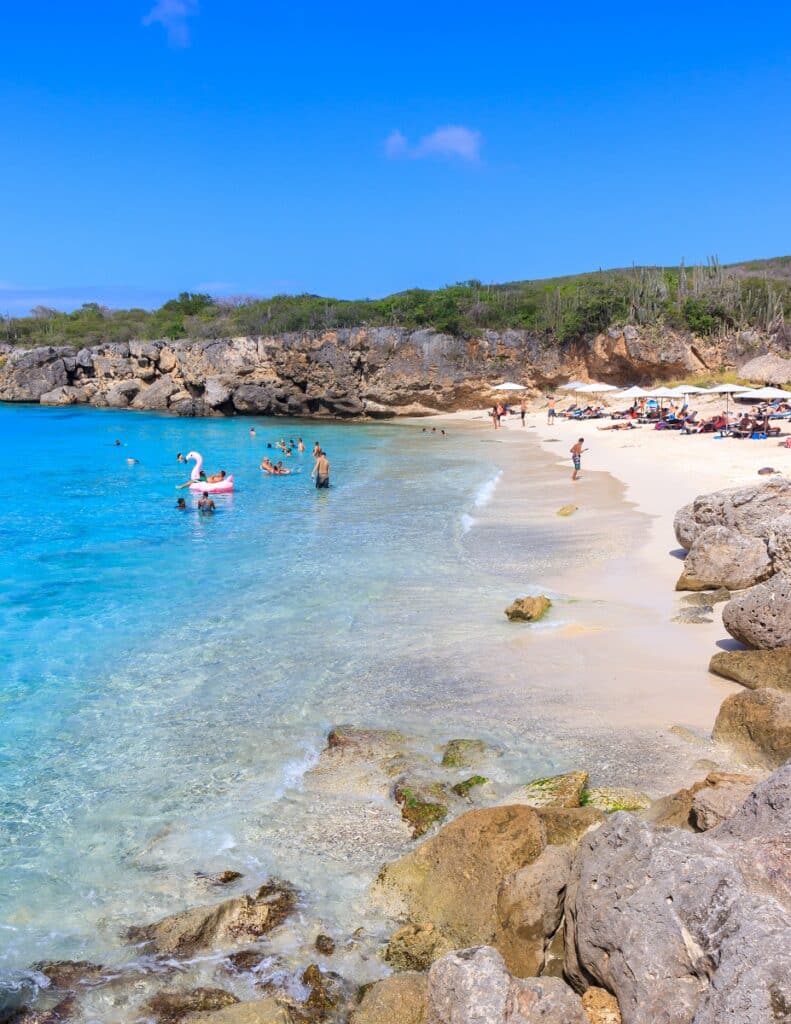
4. Playa Lagun
What a beauty! One of my favorite beaches for snorkeling in Curaçao was Playa Lagun. I never saw the seahorses that are apparently sometimes present (boo!), but I still really enjoyed puttering around the edges of the bay.
There was loads of life, and it was nice to see the coral propagation efforts that were going on just under the surface. This is also where I first spotted the Caribbean reef squid, which promptly became one of my favorite animals. I saw chain morays, porcupinefish, eels and even a remora (suckerfish)… although the latter was unfortunately not alive.
I went both diving and snorkeling here. The dive school owner at Bahia Lagun was nice and helpful, and you can rent your snorkel gear here if you don’t have any. You can also use their shower in exchange for a small fee.
Playa Lagun has beach beds for rent and there’s a restaurant on the right hand side (as seen from the beach) where you can get some food and a cocktail. The beach itself is small, not too busy and mainly popular with locals.
| Amenities? | Some |
| Busy? | Medium |
| Easy to reach? | Yes |
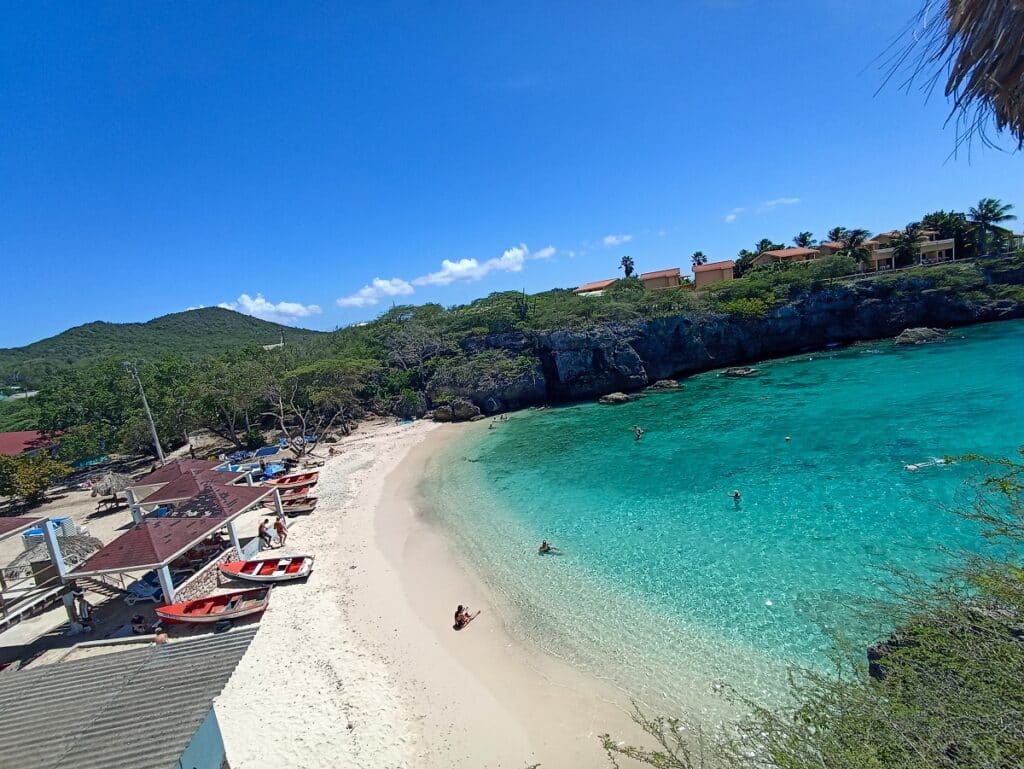
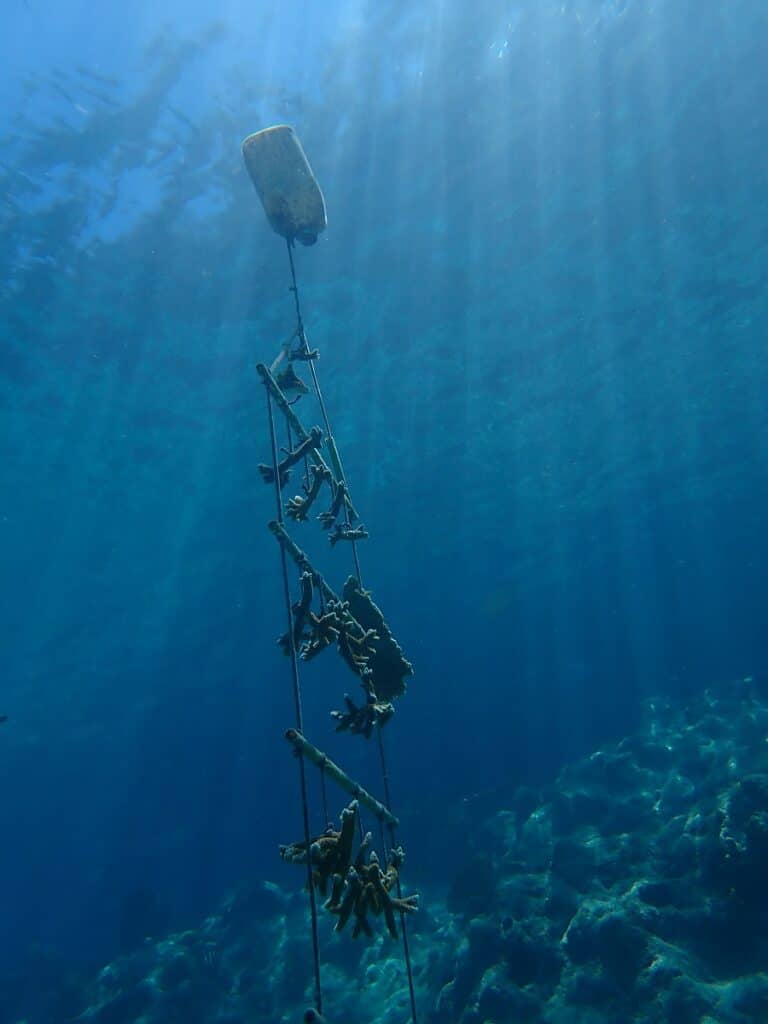
5. Tugboat beach
One of the disadvantages of snorkel is that you don’t always get to see the coolest bits the ocean has to offer. The reef is too deep to reach, the shipwrecks are too deep to reach… or are they? Not at Tugboat Beach!
If you’ve ever wanted to snorkel a shipwreck, this one’s for you. The tugboat wreck located on the left-hand side of this beach at only around 5m/16 ft of depth may be small, but it’s covered with corals and a haven for small fish, making it quite a sight to see. There’s also a submerged anchor, amazing sponges and other life on the dock pillars and just excellent snorkeling in general.
Once you’re done snorkeling, you can rent a chair and order some basic snacks or drinks from the super-friendly beach owner. Or participate in the “make your own souvenir” workshop, where you’ll paint a piece of real driftwood! Overall, Tugboat Beach is well-maintained and has everything you need for a wonderful beach day.
You can find everything you need to know to visit this beach in my full guide to snorkeling Tugboat Beach!
| Amenities? | Yes |
| Busy? | Yes |
| Easy to reach? | Yes |
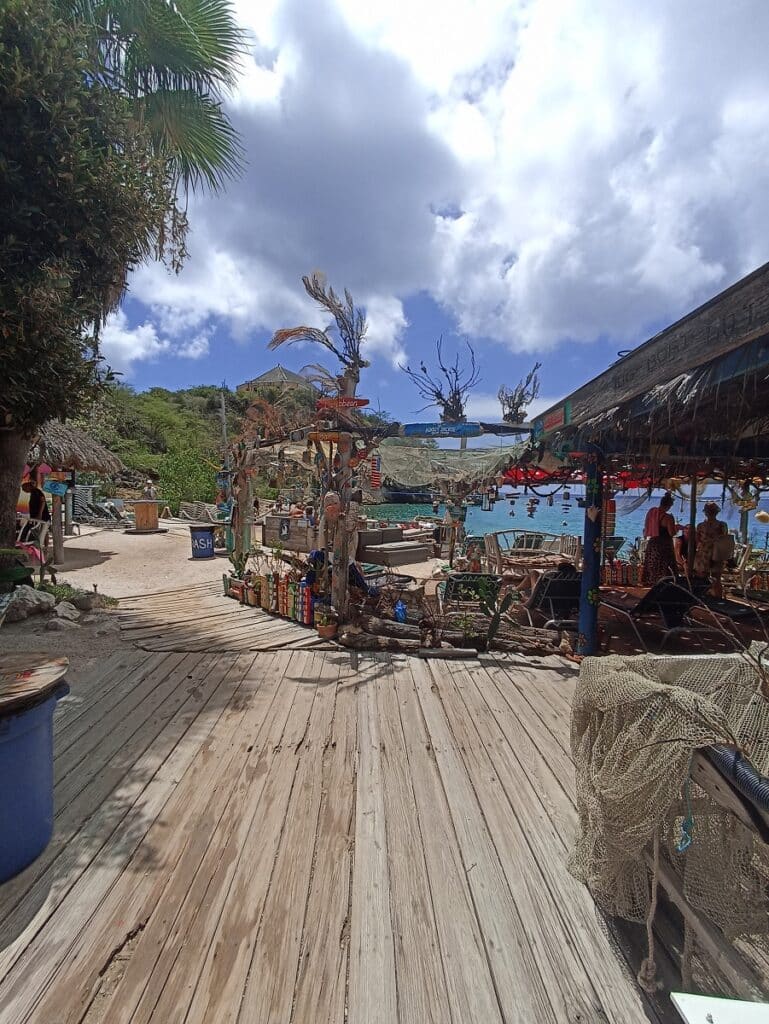
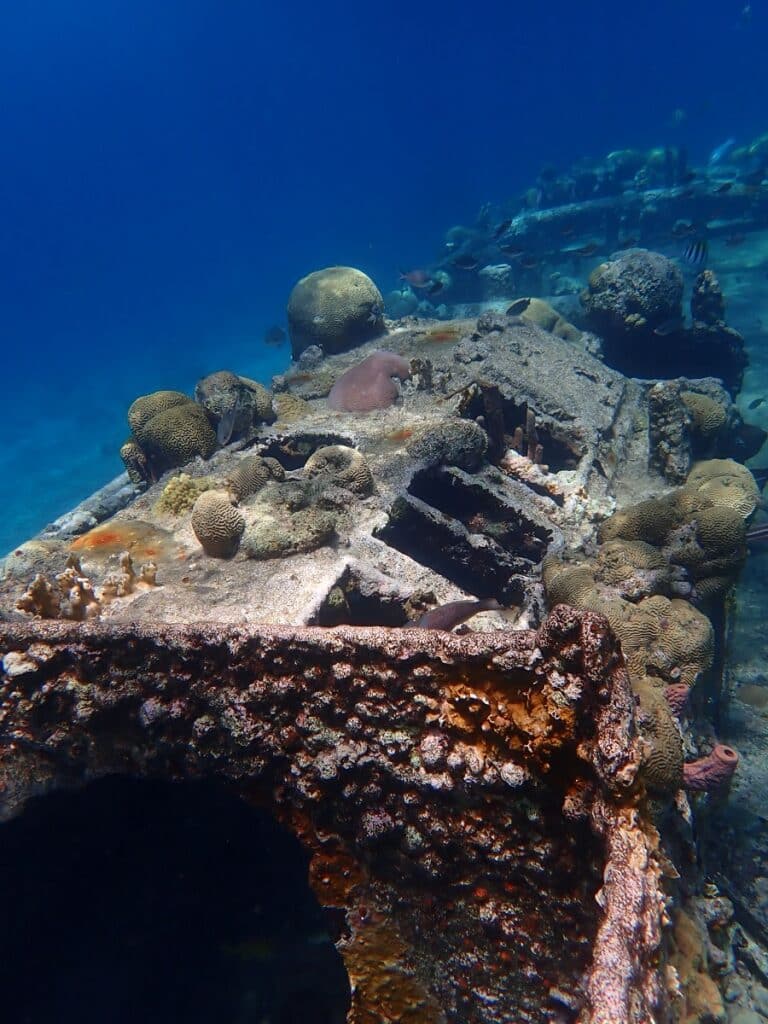
6. Playa Kalki
This beach is mainly known for the fantastic diving it offers: it hosts a reef that’s referred to as Alice in Wonderland due to its mushroom-shaped coral formations. So does this mean Playa Kalki is only worth visiting if you have a dive license? Nope! The snorkel is also pretty nice, with plenty of corals and fish to behold.
“Kalki” means limestone in the local language of Papiamentu. It refers to the white coral rubble present on this and many other beaches on the island. This one’s quiet and pretty, with plenty of shade due to the trees and generally not too many people around.
In terms of amenities, there’s a dive school here for all your equipment renting needs. There’s also a little snack bar, although that was closed when we visited. Besides that, it’s just you and the ocean, baby!
| Amenities? | Limited |
| Busy? | No |
| Easy to reach? | Yes |
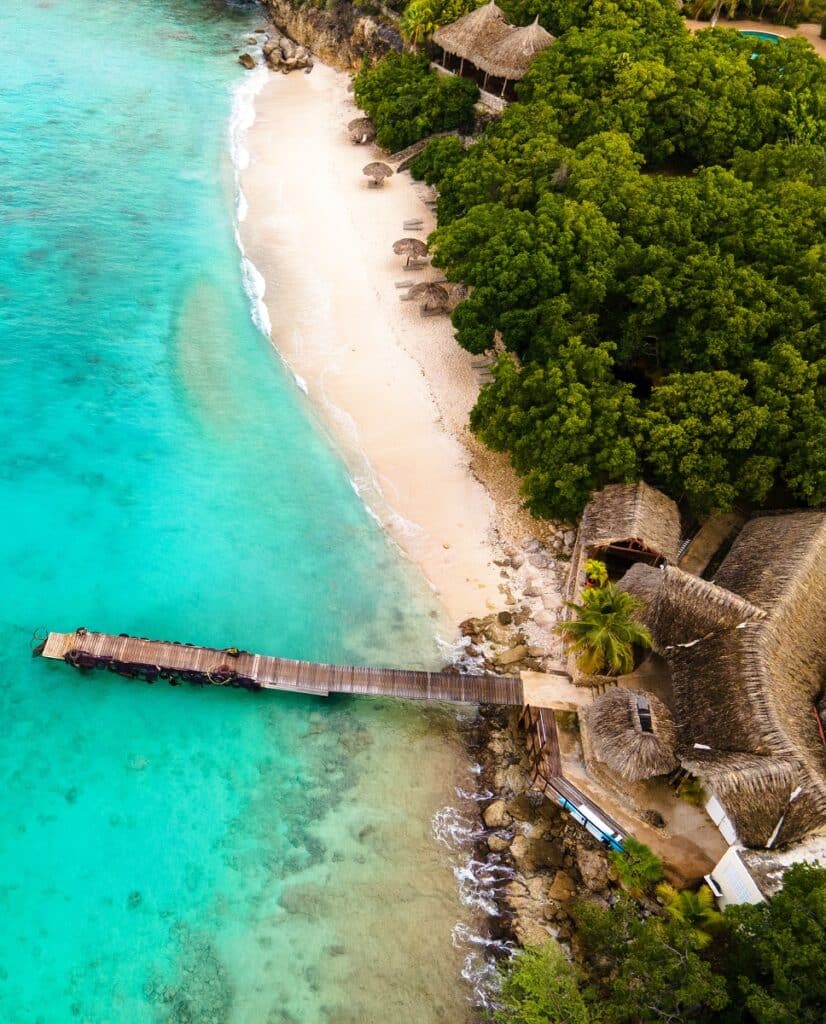
7. Playa Porto Marie
One of the more popular options in the area, Playa Porto Marie is a favorite among all types of beachgoers, from the loungers to the snorkelers and divers to the partiers. It really has everything you need. There are even some friendly local pigs that sometimes roam onto the beach.
Among divers, Porto Marie is appreciated for its fascinating double reef, but even in the shallows there’s plenty to see for snorkelers. The water is clear and you’ll spot big blocks in the water where coral is being grown in an attempt to help conserve and restore the reef. Pretty cool!
In terms of amenities, Playa Porto Marie has everything a beach could offer. There’s food, drinks, music, a dive school, beach chairs and more. Do remember that you’ll need to pay an entrance fee and it can get a little crowded, but don’t let that stop you from visiting.
| Amenities? | Yes |
| Busy? | Yes |
| Easy to reach? | Yes |
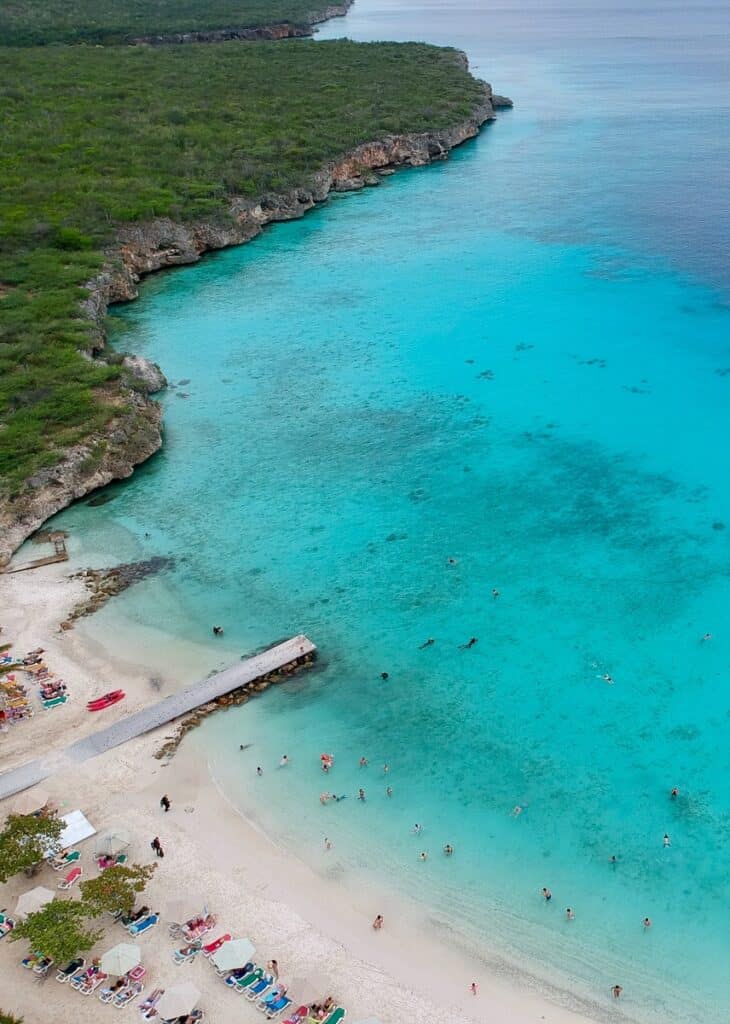
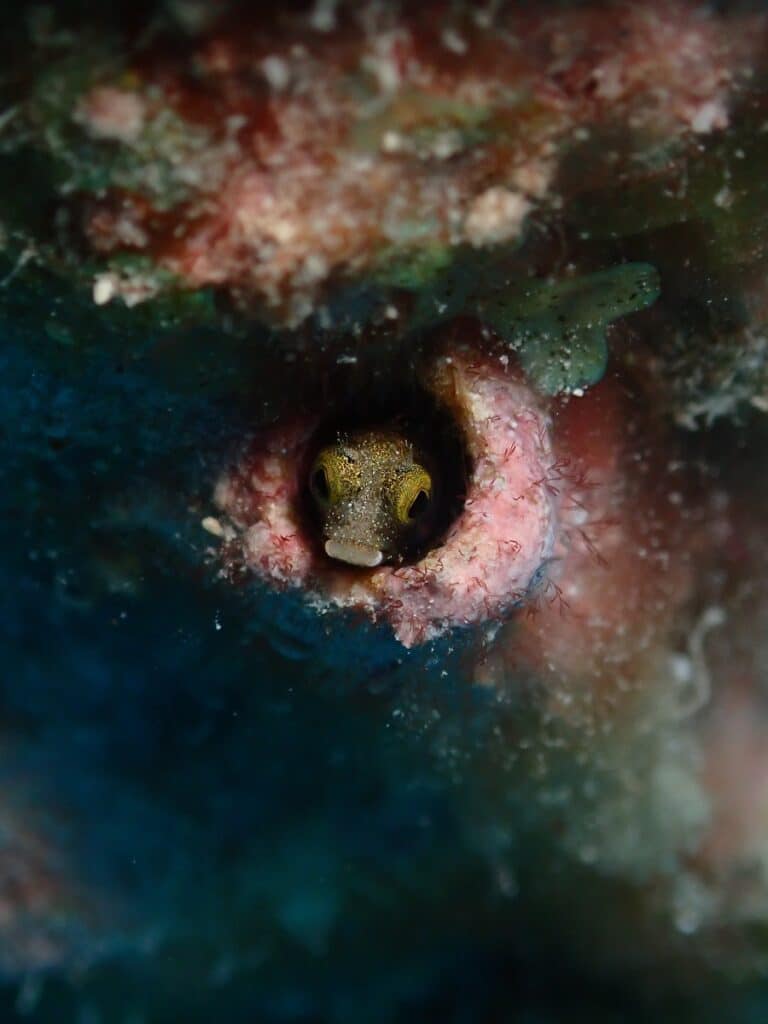
8. Snake Bay or Playa Wachi or Slangenbaai
We were assured by locals that there are no snakes present at Snake Bay, also known as Playa Wachi. Apparently, the name was instead derived from the fact that it’s a great place to fish for eel!
Located in the village of St. Michiel, Snake Bay is the perfect spot if you like to visit smaller, less busy beaches. There are always some locals present, but it’s rare to run into herds of holiday crowds here. This is a popular dive site as rare coral spawning events can be seen during certain times of the year, but it’s not a bad choice at all for snorkel either.
You’ll spot a good bit of coral with all its accompanying fish and invertebrates in the shallows at Snake Bay. It’s also quite easy to reach the reef drop-off, although as always, this might be a little too deep for most snorkel enthusiasts.
| Amenities? | Limited |
| Busy? | No |
| Easy to reach? | Yes |
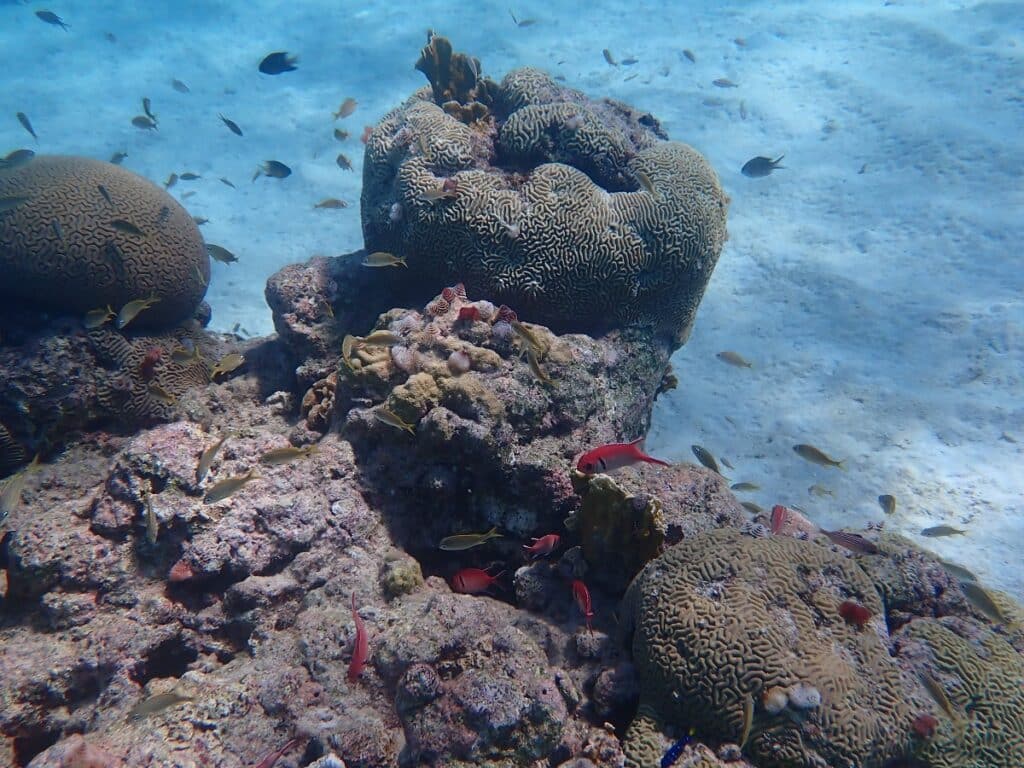
9. Jan Thiel Bay
Sometimes referred to as a sort of “natural swimming pool”, Jan Thiel Bay is a shallow bay with a popular beach, surrounded by plenty of restaurants and even some shops. A great place to get some snorkel in: just make your way to the sandy beach area and hop in.
Jan Thiel Bay has all the amenities you could ask for, including food and drinks being served right at your bed at the beach itself. This does mean it can get pricey, and Jan Thiel Beach itself not the quietest spot either by any means, but I’d say it’s worth a visit thanks to its uniquely warm, shallow and lively waters.
If you need gear, dive center Scuba Do is a hop, skip and a jump away.
| Amenities? | Yes |
| Busy? | Yes |
| Easy to reach? | Yes |
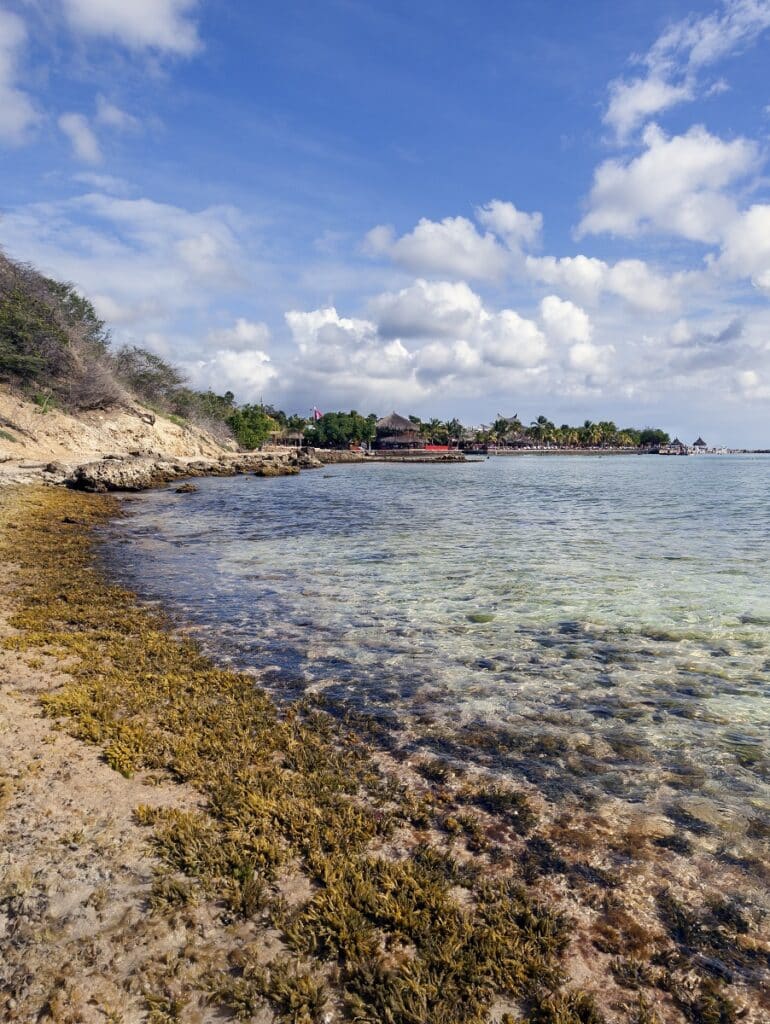
10. Kokomo Beach or Vaersenbaai
Another popular but chilled-out spot not too far from the capital of Willemstad that offers great snorkel is Kokomo Beach. The water here is clear and there are loads of beautiful corals to be seen even in the shallows. Above the water, you’ll also be able to spot native pelicans, as well as the iguanas that are so ubiquitous on the island.
Access to Kokomo Beach is free, although beach beds have to be rented. There’s a dock leading into the sea, a swing set in the water for a nice little photo op, a resident dive shop and a restaurant. I didn’t catch it because I was too busy snorkeling, sleeping and repeating, but apparently there’s even good partying to be had here at night.
Of course, this place does get a bit crowded, but I think its natural beauty makes it more than worth a visit. Just swim along the bay edges to get away from everyone else and have your private ocean moment!
| Amenities? | Yes |
| Busy? | Yes |
| Easy to reach? | Yes |
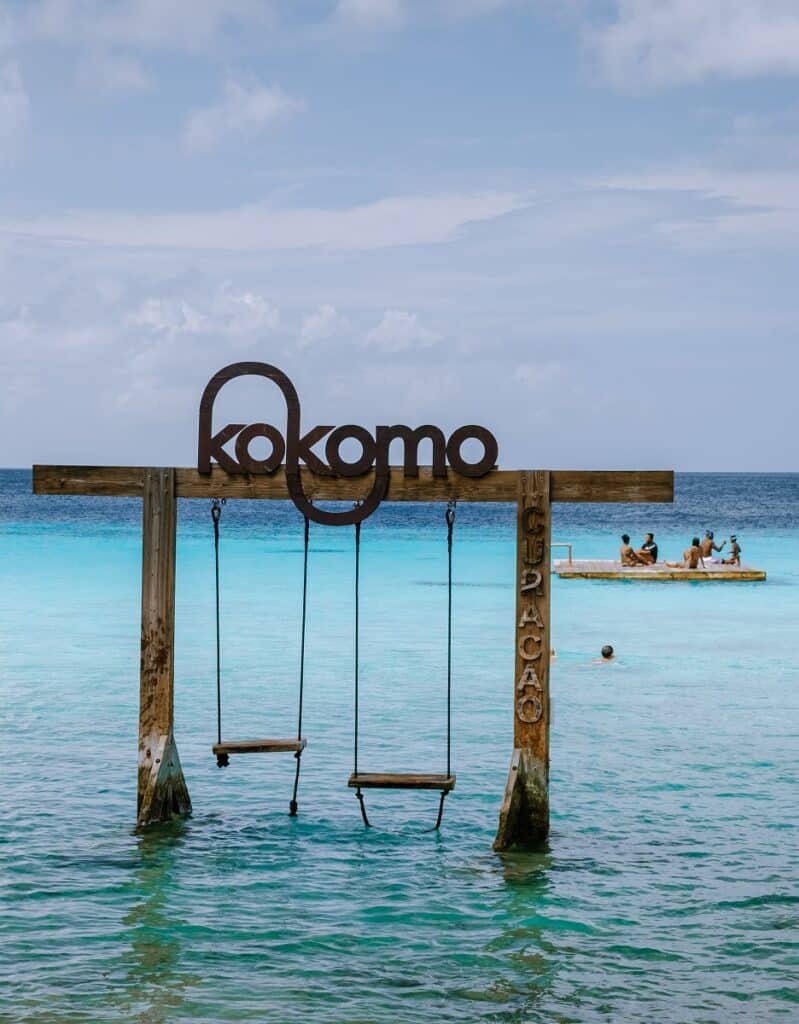
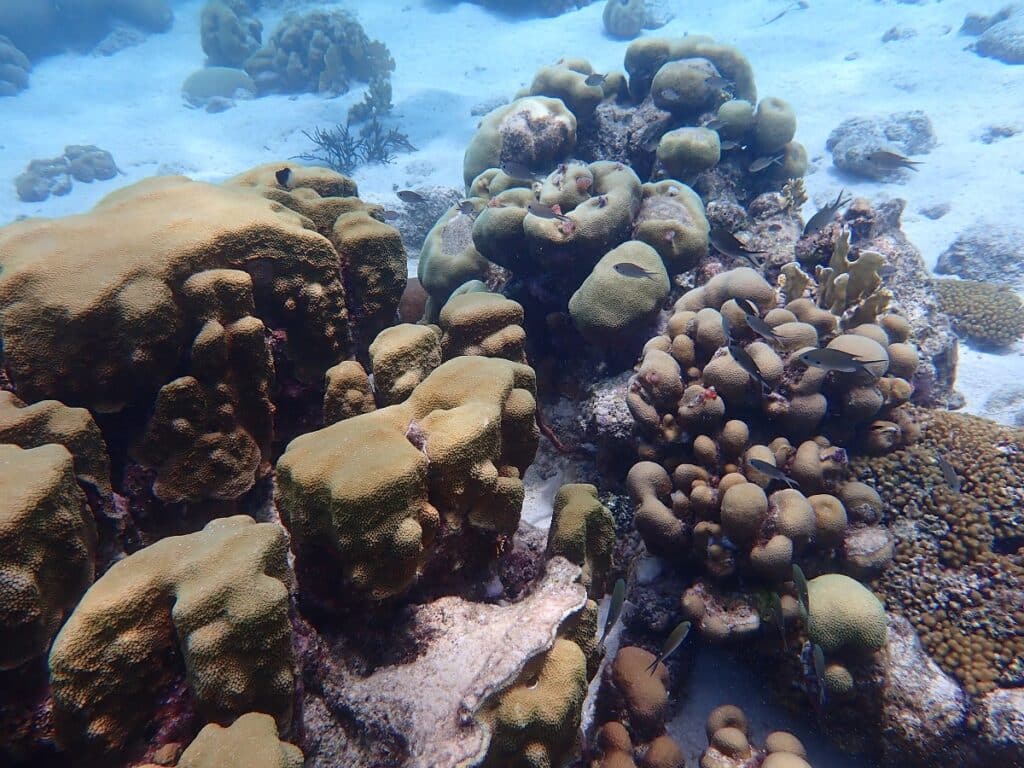
11. The Blue Room
Ever wanted to visit an underwater cave? Well, you can! The Blue Room is one of the most popular snorkel spots in Curaçao. Named after the blue hue that the light falling into the cave gives, it’s a little hard to reach, but I thought it was worth it.
You’ve got a few different options if you want to have a look at The Blue Room. First off, you can walk there; it’s about a 30-minute walk from nearby Playa Santa Pretu. Some will tell you that it’s a dangerous hike, but it’s actually not too bad.
You can also head to Playa Santa Pretu and make your way to the restaurant there, which offers multiple boat trips daily to the cave and a submerged shipwreck. We didn’t go for the boat option ourselves, but instead rented a kayak at the restaurant and paddled our way to the cave on our own for something a little different.
The kayak trip seemed quite safe, although the current wasn’t in our favor on the way back, and you pass another nice small cove with black sand on the way. Once you get to the cave, which is reached by just paddling along close to the shore, there’s a buoy that you can tie your kayak to and hop off. Don’t forget to bring an underwater torch!
Remember: you have to be a good swimmer to be able to get into the cave by diving under the submerged entrance. It’s a good few meters underwater without being able to come up for air.
| Amenities? | No |
| Busy? | Medium |
| Easy to reach? | No |
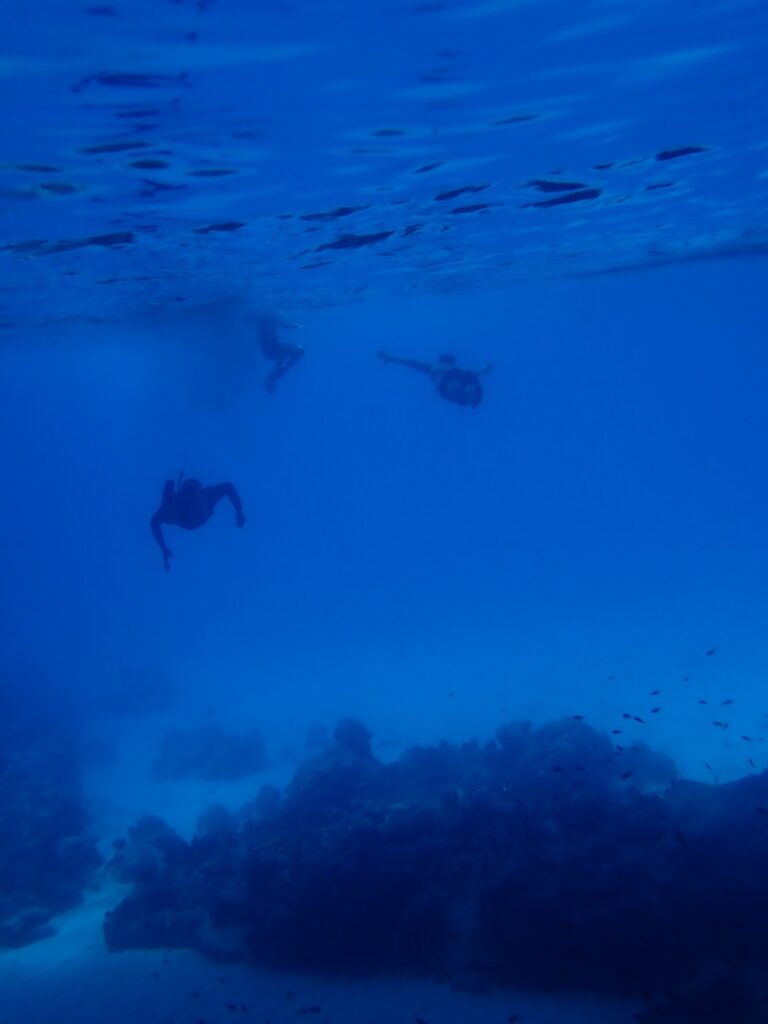
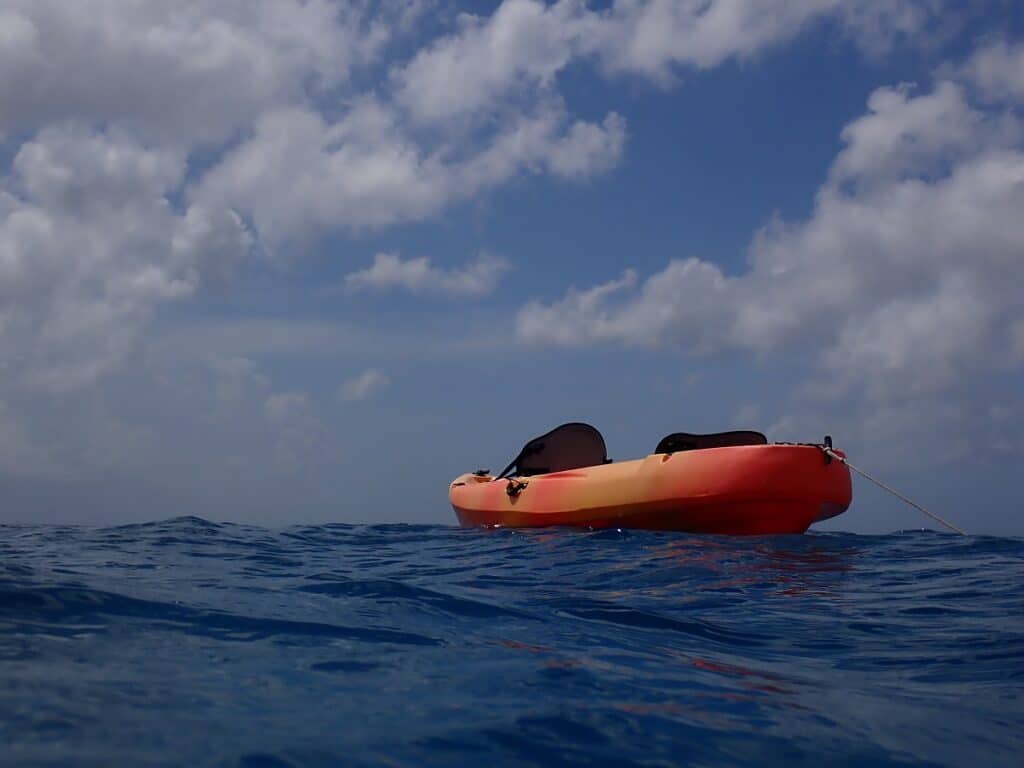
BONUS: Klein Curaçao
Ever heard of Curaçao’s baby sister, Klein Curaçao (English: Little Curaçao)? This tiny uninhabited island is located a boat ride away and is by far my favorite option for a day trip. White beaches, azure waters teeming with life, wonderful snorkel opportunities and even an old lighthouse… don’t miss it.
You can find out everything you need to know about this micro paradise island in my full guide to visiting and snorkeling Klein Curaçao.
| Amenities? | Yes |
| Busy? | Yes |
| Easy to reach? | Only by boat |
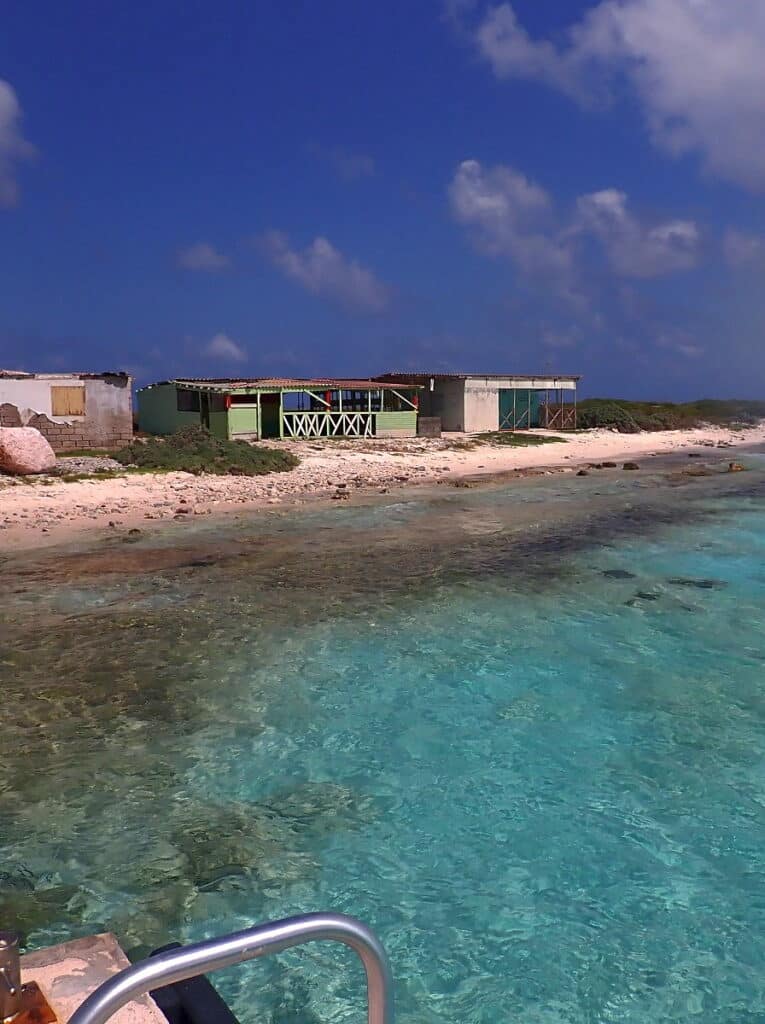
Species you’ll see while snorkeling in Curaçao
The amount of different marine life you’ll spot while snorkeling in Curaçao borders on mind-boggling (at least for me, since my home sea is the cooler Mediterranean).
I’m not even going to attempt to describe all the different corals and sponges, but here are a few of my favorites that I got to see for myself:
Fish
- Moray eels: chain moray (Echidna catenata), spotted moray eel (Gymnothorax moringa), green moray eel (Gymnothorax funebris), etc. – careful, they bite!
- Filefishes: scrawled filefish (Aluterus scriptus), whitespotted filefish (Cantherhines macrocerus), etc.
- Boxfishes: smooth trunkfish (Lactophrys triqueter), Honeycomb cowfish (Acanthostracion polygonius)
- Porcupinefish (Diodon holocanthus)
- Parrotfish (Scaridae)
- Western Atlantic trumpetfish (Aulostomus maculatus)
- Threespot damselfish (Stegastes planifrons)
- Common sand diver (Synodus intermedius)
- Soldierfish (Myripristis sp.)
- Caribbean sharpnose puffer (Canthigaster rostrata)
- Atlantic blue tang (Acanthurus coeruleus)
- French angelfish (Pomacanthus paru)
- Sharknose goby (Elacatinus evelynae)
- Goldspotted eel (Myrichthys ocellatus)
Unfortunately, there are also a lot of lionfish present. These are beautiful to see, but they’re also highly invasive in this area. Some dive schools even offer a course that allows you to hunt them!
Invertebrates
- Sea urchins: Rock boring sea urchin (Echinometra lucunter), West Indian sea egg (Tripneustes ventricosus), slate pencil urchin (Eucidaris tribuloides)
- Caribbean reef squid (Sepioteuthis sepioidea)
- Bearded fireworm (Hermodice carunculata)
- Pederson’s cleaner shrimp (Ancylomenes pedersoni)
- Coral banded shrimp (Stenopus hispidus)
- Arrow crab (Stenorhynchus seticornis)
- Caribbean reef octopus (Octopus briareus)
- Christmas tree worm (Spirobranchus giganteus)
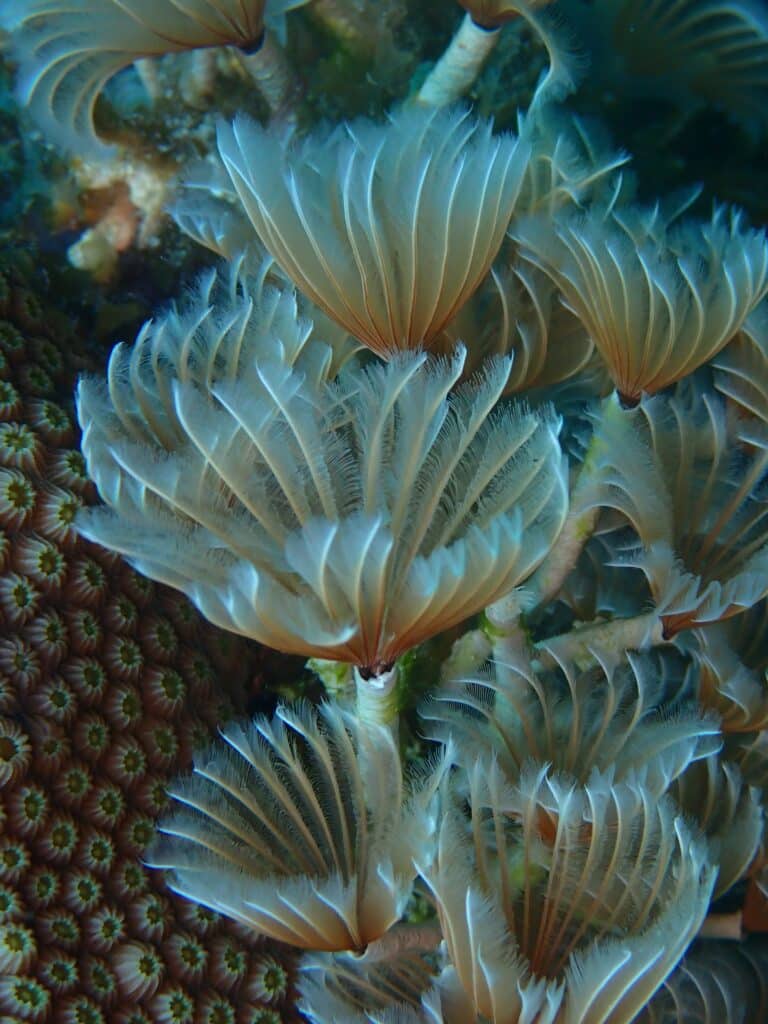
Other things to do on Curaçao
Diving
If you love snorkeling, you may adore diving as well. Curaçao would be the perfect place to try a dive or get your diving license: the water is warm and there’s loads to see. Diving allows you to reach the deeper reefs in a way that snorkel doesn’t.
I already had my PADI Open Water license, so I went diving as well as snorkeling at a lot of the beaches mentioned in this article. My buddy and I started off by booking a double guided dive at Kokomo Beach and Snake Bay with The Diveshop Curaçao at Piskadera Bay (which isn’t a bad snorkel beach itself). This was great for getting a feel of what to expect.
We really liked the shop, so we continued going there for equipment rental and even dived their home reef. Give it a try, you might love it!
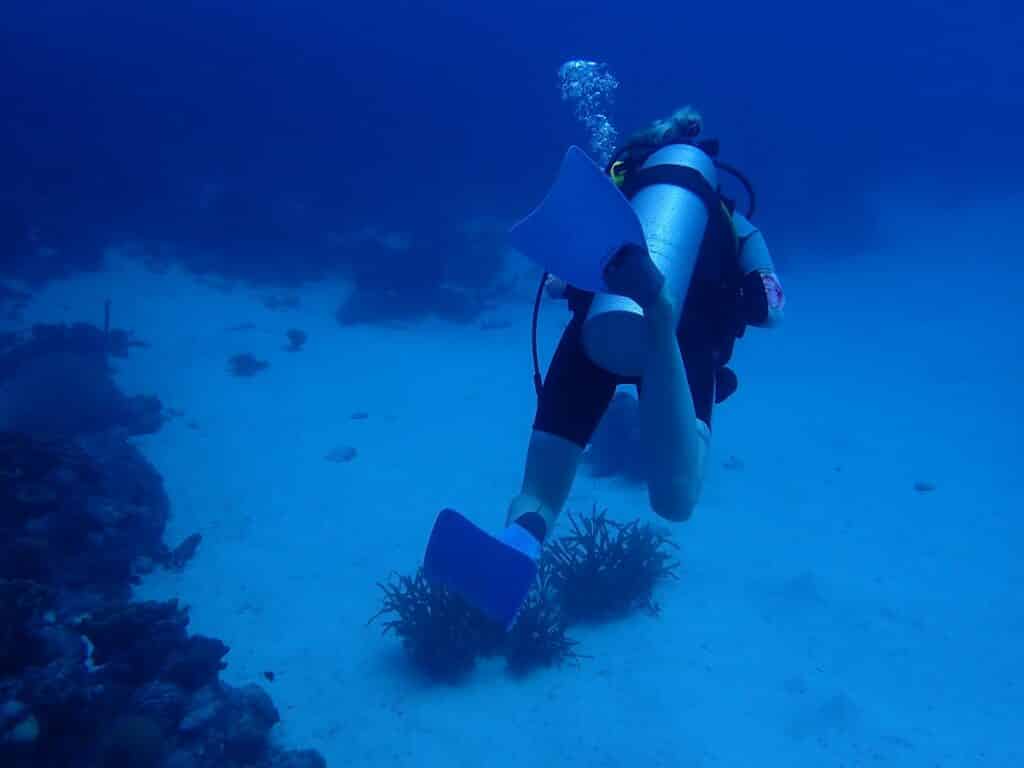
Shete Boka National Park
As you’ve seen in this post, Curaçao’s beaches are mostly located on the southern side of the island. On the northern windward side, the sea is generally too rough to go snorkeling or diving, but that doesn’t mean there’s nothing to do here.
We really enjoyed Shete Boka National Park, which centers around seven wave-battered inlets that can be explored by car or (if you’re particularly heat-resistant) on foot. It’s rugged, scenic and the perfect way to safely enjoy the island’s wilder side. Sea turtles come to lay their eggs at some of the Bokas, and the park is dedicated to protecting them so the young can make it safely back into the ocean after they hatch.
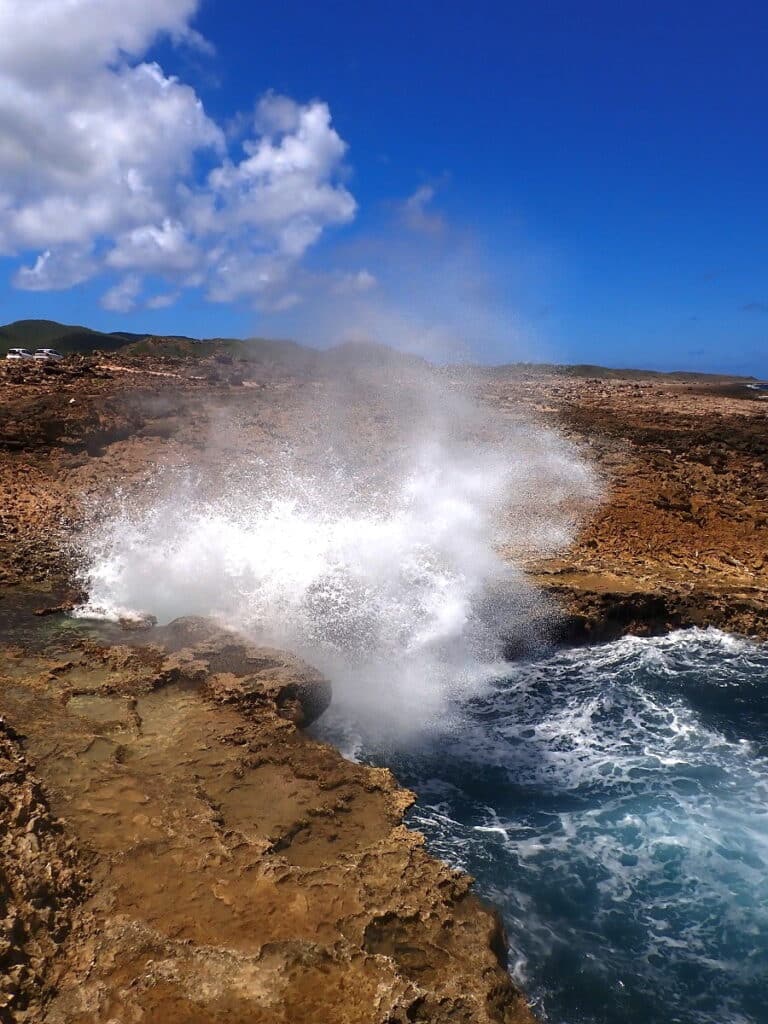
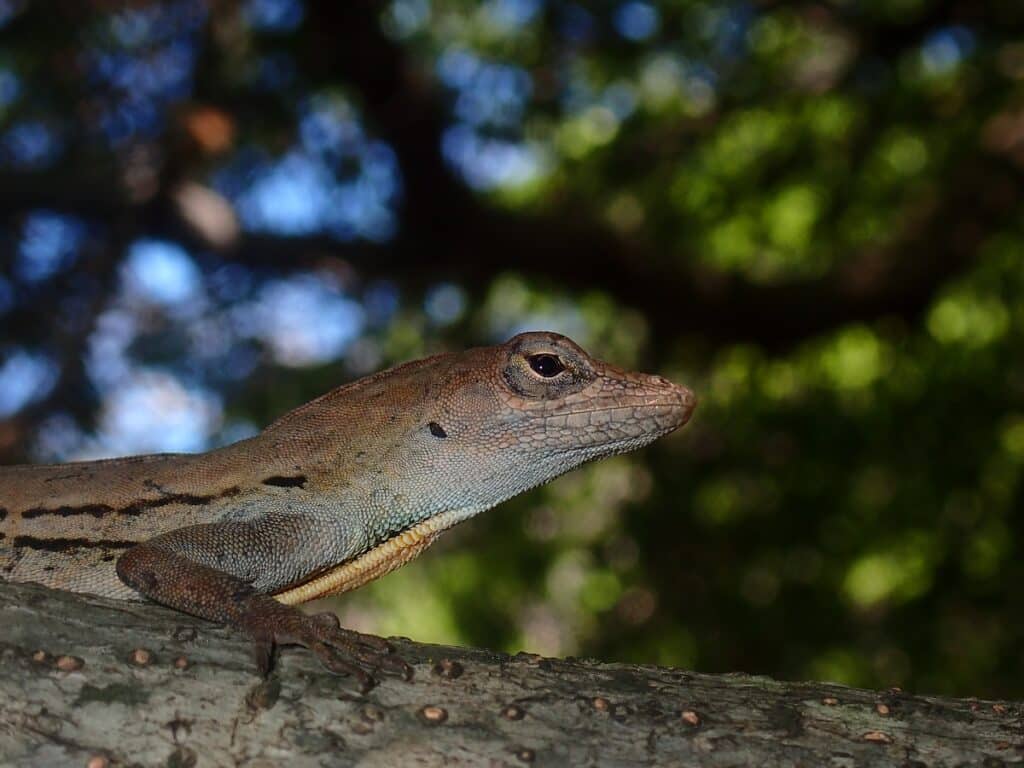
Hike Christoffel Mountain
I’ll come right out and admit I did not do the relatively challenging 1.7 mile/2.7 km hike up Christoffel Mountain myself. It was way too hot and humid when I visited Curaçao for me to dare attempt it (I’m more of an underwater person), but many folks do.
Located on the western side of the island, Mt. Christoffel can be hiked year-round. Remember to get to the start of the trail early to buy your pass (10 am is the latest you can start), so you can avoid some of the heat and crowds. Bring lots of water and don’t forget to enjoy the view at the top!
Explore Willemstad
When you’re all done hiking and hanging out on the beach, you can head to Curaçao’s capital of Willemstad. With a population of around 135,000, this is not a large city, but there’s plenty to do. We enjoyed eating typical Caribbean and Dutch food, having a mojito and wandering around.
When you’re in Willemstad, don’t miss the classic view from the Otrabanda side of the floating Queen Emma pontoon bridge that you see in all the photos. As an added bonus, the bridge is lit up at night. We spent one evening sitting on it watching a massive thunderstorm roll in: an amazing experience and 100% free!
Other things to do in the city include:
- Visit the Kura Hulanda museum, which offers a lot of insight into both African art and the Atlantic slave trade
- Visit the maritime museum, which saved us on a rainy afternoon
- Eat at the Old Market (Plasa Bieu) and try cheap + delicious local cuisine
- Visit the Curaçao Rif Mangrove Park, a relatively new city park with mangrove trees, wood walkways and kayak rental
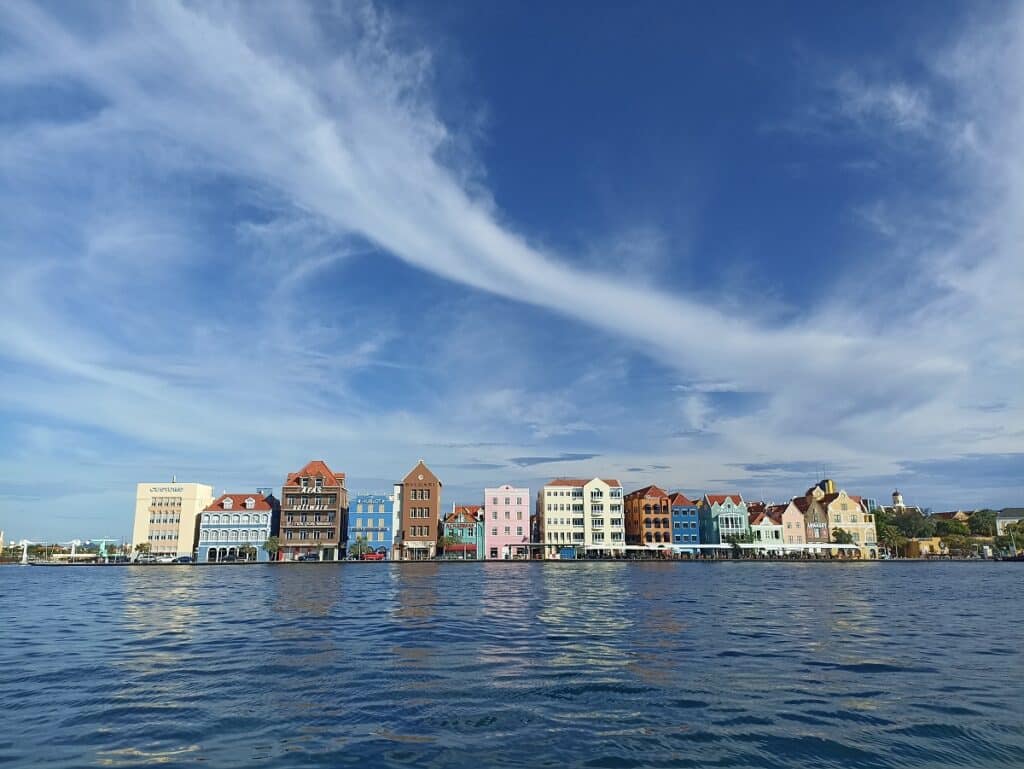
Where to stay on Curaçao
Where you should stay on Curaçao will obviously depend on what you want from your holiday. We wanted a spot that would serve as a good base to explore the entire island and that wasn’t too remote, as we do enjoy a nice cocktail after getting back from a long day of snorkeling. As such, we chose Otrabanda in Willemstad.
Other options include:
- The Sabana Westpunt area for hiking and to be closer to a lot of the good beaches.
- Jan Thiel for family-oriented holidays.
- One of the multiple dive resorts if you want to get a LOT of diving and snorkeling in.
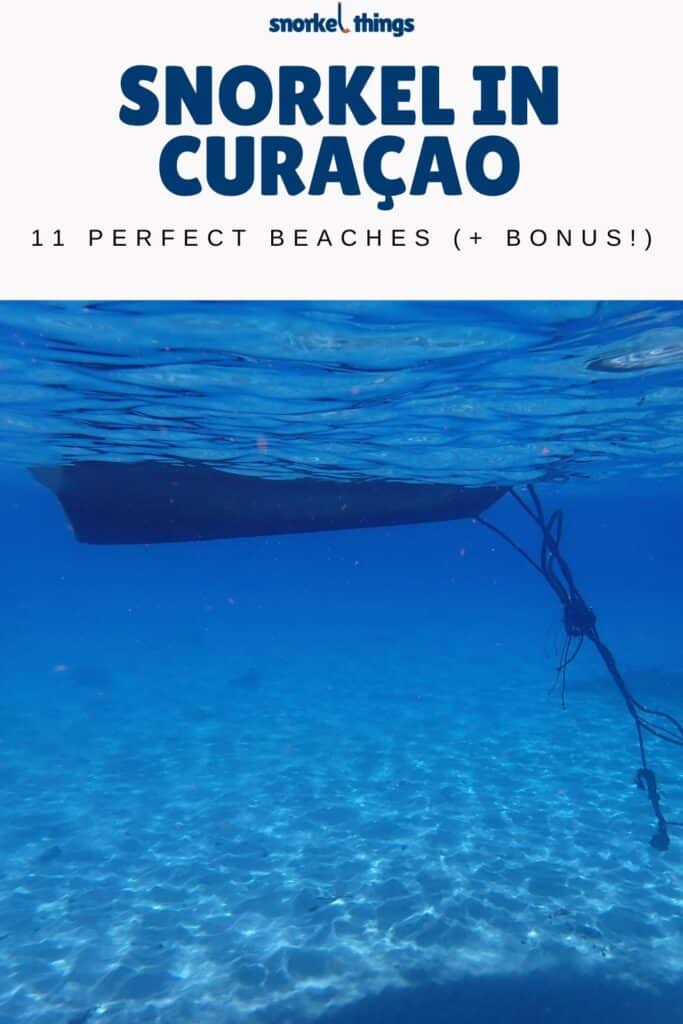
If you have any more questions about the best places to go snorkeling in Curaçao or if you want to share your own experiences on the island, don’t hesitate to leave a comment below!

